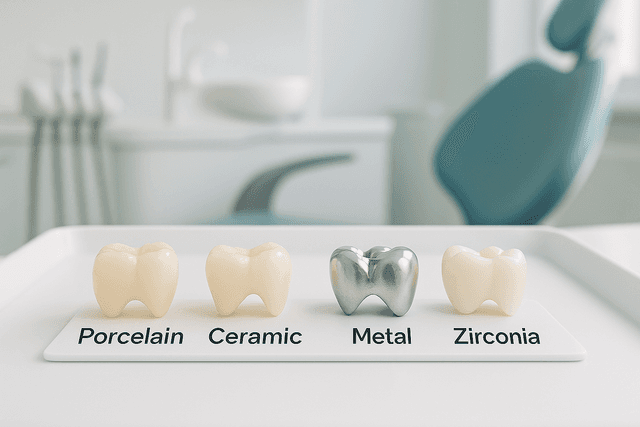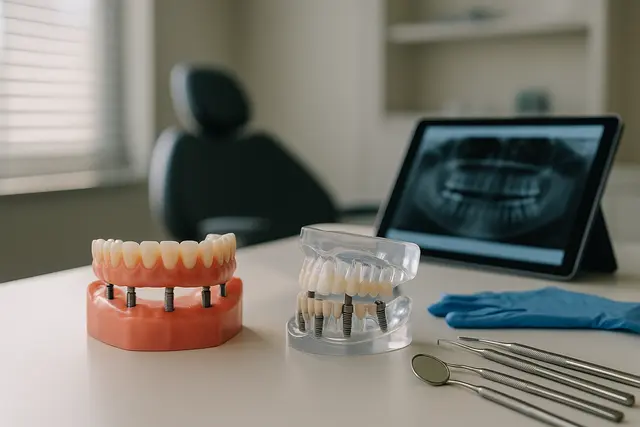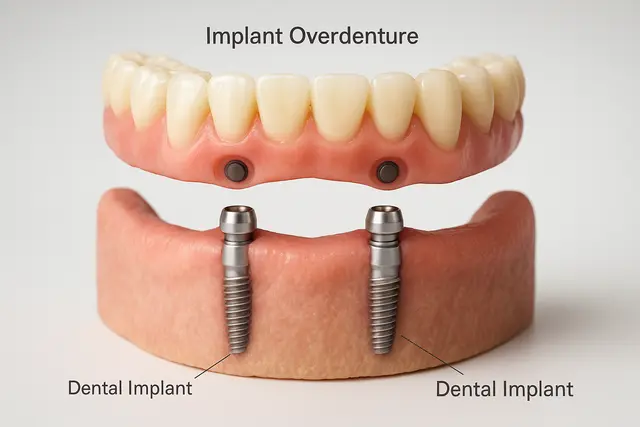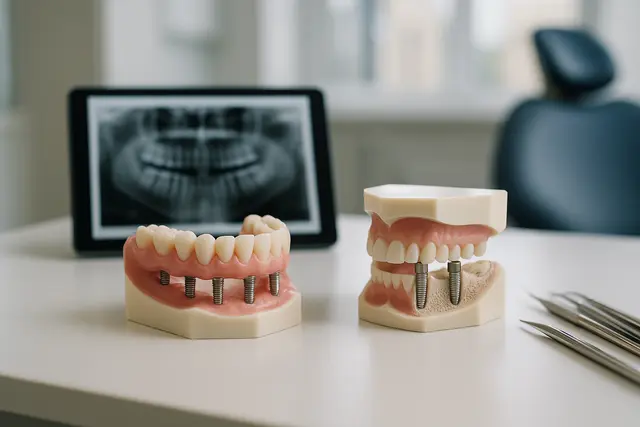Prosthodontics
7 min read
Jul 15, 2025
What Are Dental Crowns Made Of? Choosing the Right Material for You
If you’ve been told you need a dental crown, you’re probably wondering what exactly that means, and what your new tooth will be made of. With so many materials and options out there, it’s not just about patching things up. It’s about choosing something that fits your smile, feels comfortable, and holds up over time.

No one dreams of needing a dental crown. But when your tooth is cracked, broken, or worn down, getting the right crown material isn’t just about fixing your smile, it’s about restoring your confidence and comfort, too.
Whether you’ve chipped a tooth biting into a rogue popcorn kernel or your dentist mentioned a crown during your regular dental checkup, understanding your options matters. Because yes, dental crowns are made from a variety of materials, and no, they’re not all created equal.
So, what kind of crown is best for your tooth? Let’s break down the different types of dental crowns available, what they’re made of, and how to pick the one that fits your life (and mouth) best.
Why You Might Need a Dental Crown
Crowns aren’t just about looks. A dental crown is a cap that fits over a damaged, weak, or broken tooth to protect it and restore its shape, strength, and function. Think of it like armor for your tooth, but prettier.
You might need a dental crown if you’ve got:
Broken teeth from injury or grinding
Severely decayed or worn down teeth
A root canal-treated tooth that needs protection
A large filling that’s failing
A dental implant that needs a tooth-like cap on top
Crowns are also used to cover dental implants or improve the appearance of misshapen teeth. The crown is made in a dental laboratory, custom-shaped to match your bite and blend with your natural teeth.
Understanding the Type of Dental Crown That’s Right for You
There’s no one-size-fits-all crown. The type of dental crown you choose (or your dentist recommends) depends on a few things: where the tooth is, how much of the original tooth is left, your bite, your budget, and your personal preferences.
Crowns are primarily used to protect and strengthen your teeth, but the crown material you choose plays a big role in how long it lasts and how it looks. So let’s look at the most common types of crowns and what each is made from.
Exploring Every Type of Dental Crown
When it comes to your dental health, you deserve to know what’s going in your mouth. Here are the main materials used to create crowns, and what makes each one shine (or not).
Porcelain or Ceramic Crowns
If you’re getting a crown on front teeth, a ceramic crown or porcelain crown is usually the go-to. These crowns are made of porcelain or other advanced ceramics that mimic the color and translucency of natural teeth.
Pros:
Great for visible areas like front teeth
Blends beautifully with your smile
Metal-free, good for patients with allergies
Cons:
Not as strong as metal crowns for back teeth
Can chip under heavy bite pressure
Porcelain or ceramic crowns are a great option when appearance matters most. And while they’re often used for cosmetic purposes, they still offer reliable strength for moderate wear.
Zirconia Crowns
Zirconia crowns are made from zirconium dioxide, a material used in medical-grade ceramics. A zirconia crown is super strong (seriously, it’s tough) but still looks fairly natural. You’ll often find these on back teeth because they can handle more pressure.
Pros:
Extremely durable and fracture-resistant
Biocompatible with gums and natural teeth
Can be shaded to match your smile
Cons:
May not look quite as natural as all-porcelain crowns
Can wear down opposing teeth if not properly polished
Many dentists now use layered zirconia to improve aesthetics, so if you want the durability of metal with the look of ceramic, this type of dental crown might be your match, especially if you're covering a tooth cap for front teeth.
Metal Crowns
Metal crowns, including gold crowns, are made from alloys containing gold, palladium, nickel, or chromium. These crowns are known for their incredible strength and long lifespan.
Pros:
Very durable, crowns can last 20+ years
Requires less tooth structure to be removed
Rarely chips or breaks
Cons:
Not tooth-colored (unless you love the bling)
Usually not used for front teeth
Metal crowns are often the best option for molars or back teeth, especially if you need something that can survive clenching, grinding, or chewing hard foods.
PFM Crowns
PFM crowns (porcelain-fused-to-metal) combine the strength of metal with the look of porcelain. The core is metal, and it’s covered with a tooth-colored porcelain shell.
Pros:
Offers good strength and appearance
Widely used and affordable
Cons:
The metal underneath can sometimes show as a dark line near the gum
Porcelain layer may chip over time
PFM crowns are a solid choice if you want strength but also care about aesthetics. They’ve been around for decades, and there’s a reason they’re still popular.
Resin Crowns
Resin crowns are made from composite resin material, the same stuff used in tooth-colored fillings. These crowns are less expensive than other types and usually used temporarily or in low-stress areas.
Pros:
Less expensive than other types
Easy to repair or adjust
Cons:
Wear down faster
More prone to fractures or chips
If you’re getting dental crowns and looking to save money upfront, resin crowns can help, especially if you're managing dental implant cost.
Stainless Steel Crown
A stainless steel crown is pre-made and commonly used as a temporary crown or for children's baby teeth.
Pros:
Inexpensive
Quick and easy to place
Durable for short-term use
Cons:
Not custom-fitted for aesthetics
Not suitable for long-term adult restorations
Temporary crowns can either be made of resin or stainless steel, and they’re often used while your permanent crown is being made. For quick fixes or damage, consider this guide to emergency crown repair.
Let’s Talk About Crown Material: What’s Actually Used?
So, what’s a dental crown made of? Here’s a quick recap of the crown materials used today:
Porcelain or ceramic: Natural look, great for front teeth
Zirconia: Strong, durable, can be aesthetic
Metal (including gold): Long-lasting, ideal for back teeth
PFM: Best of both worlds, but may show metal over time
Resin: Affordable and easy, but not long-term
Stainless steel: Mostly used for kids or temporary needs
Each crown material has its place, the key is finding the one that fits your smile, lifestyle, and budget.
The Dental Crown Procedure: What to Expect
Getting a dental crown typically takes two dental visits, though some practices offer same-day crowns using CAD/CAM tech. Here’s how it usually goes:
Prep the Tooth: Your dentist numbs the area, shapes the damaged tooth, and takes impressions.
Fitted with a Temporary Crown: A temporary crown is placed to protect the tooth while your permanent crown is being made.
Dental Lab Magic: The impressions are sent to a dental lab, where your crown is custom-made.
Crown In Place: At your second appointment, the dentist checks how the crown fits and bonds it to the tooth.
And just like that, your tooth has a fresh start.
Benefits of Dental Crowns You Should Know
Crowns provide more than just cosmetic fixes, they’re a long-term solution for real dental problems. The benefits of dental crowns include:
Restoring broken teeth and damaged teeth
Strengthening weak or worn teeth
Holding a dental bridge in place
Covering a dental implant procedure
Improving the appearance of stained or misshapen teeth
Protecting teeth after root canal treatment (especially if your crown fell off)
Plus, crowns can last for many years, even decades, with proper care. That’s a win in the world of dental restoration.
Choosing the Best Option for Your Dental Needs
So, which crown is best for your tooth? The answer depends on where the tooth is, what kind of wear it’ll face, and what matters most to you, appearance, cost, durability, or all three.
If you’re covering back teeth that do a lot of chewing, zirconia or metal crowns are usually the best bet. For front teeth, ceramic crowns win for their natural appearance. And if budget is a concern, resin or PFM crowns can work, just know they may not last as long.
Talk with your dental practice about your priorities so they can recommend the crown that fits your smile best.
Get a Crown, Keep Your Smile
Whether you’re dealing with a broken tooth or covering a dental implant, deciding to get a dental crown is a big move for your dental health. Crowns are a great option to restore comfort, function, and confidence in your smile, and they’re not one-size-fits-all.
From lithium disilicate crowns that balance strength and beauty, to metal crowns that never quit, crowns are designed to protect your natural teeth and support long-term oral health. And while crowns can also vary in cost, design, and longevity, they’re all crafted to help your smile feel whole again.
What Is the Best Material for a Dental Crown?
The best crown material depends on where the tooth is and what matters most to you, strength, appearance, or cost. Porcelain and ceramic crowns are ideal for front teeth due to their natural look. Zirconia and metal crowns are best for back teeth because they’re extremely durable. If you’re looking for a balance of aesthetics and strength, PFM (porcelain-fused-to-metal) is a reliable option.
How Long Do Dental Crowns Typically Last?
Dental crowns can last anywhere from 5 to 20+ years depending on the material used and how well you care for them. Metal crowns last the longest, often over two decades, while resin crowns wear out more quickly. Regular brushing, flossing, and dental checkups can extend the life of any crown.
When Is a Dental Crown Necessary?
A crown is necessary when a tooth is too damaged or weak for a filling. This includes cases like cracked teeth, worn-down enamel, or teeth treated with a root canal. Crowns are also used to cap dental implants and support dental bridges. They restore both function and appearance.
Can I Get a Temporary Crown While Waiting for the Permanent One?
Yes, a temporary crown is typically placed after your tooth is prepared and impressions are taken. It's designed to protect the tooth and maintain function while your permanent crown is being made in the lab. Temporary crowns are often made of resin or stainless steel and are not meant for long-term use.
Read Next
Related Posts

Prosthodontics
Implant Supported Dentures Overview
Missing teeth can impact more than just your smile, they can affect your confidence, comfort, and even your diet. Fortunately, modern dentistry offers a solution that’s both secure and natural-looking: implant-supported dentures. This innovative approach blends the stability of implants with the convenience of dentures to create a long-lasting, life-improving upgrade.
5 min read
Oct 29, 2025

Prosthodontics
Implant Overdentures Explained: The Hybrid Solution to Missing Teeth
Missing teeth can impact everything from your ability to eat to your self-confidence. While traditional dentures have long been a go-to solution, they often fall short in comfort and stability. Implant overdentures offer a modern alternative that combines the security of dental implants with the convenience of removable dentures, a true upgrade for those looking to reclaim their smile.
6 min read
Oct 29, 2025

Prosthodontics
Implant Retained Dentures Explained
Considering implant-retained dentures? You're not alone. As modern dentistry evolves, more people are turning to this secure, natural-feeling alternative to traditional dentures. This guide will walk you through what they are, how they work, and why they might be the solution you've been looking for.
4 min read
Oct 28, 2025
Don’t have time to research every dentist around you?
See why 30k+ patients trusted us